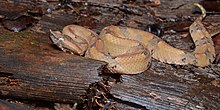
Metlapilcoatlus is a genus of pit vipers endemic to Mexico and Central America. Six species are currently recognized. The common names suggest they are able to leap at an attacker, but this is likely exaggerated. Common names for the species include jumping pitvipers and jumping vipers. The genus name comes from the Nahuatl name metlapilcohuatl, which means of the oblong grindstone held in the hand when grinding corn—alluding to the snake's short, stocky body.
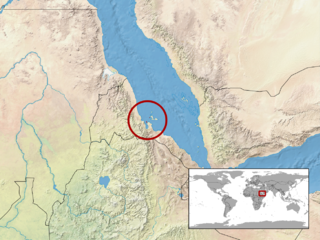
Echis megalocephalus, also known commonly as the big-headed carpet viper and Cherlin's saw-scaled viper, is a species of venomous snake in the family Viperidae. The species is endemic to one island in the Red Sea off the coast of Eritrea. There are no subspecies that are recognized as being valid.

Crotalus basiliscus, known as the Mexican west coast rattlesnake, Mexican green rattler, and also by other names, is a species of pit viper in the family Viperidae. The species is endemic to western Mexico. Like all other pit vipers, it is venomous. The specific name, basiliscus, is derived from the Greek word for king, βασιλισκος, and alludes to this snake's large size and potent venom. No subspecies are currently recognized.
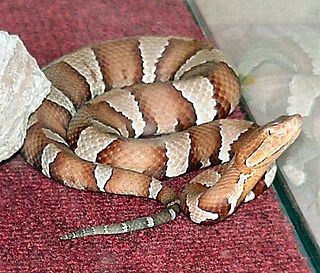
Agkistrodon contortrix pictigaster was formerly a venomous pit viper subspecies found in the Trans-Pecos region of the United States in western Texas, and northeastern Mexico. However, recent taxonomic changes do not recognize the Trans-Pecos copperhead as a valid taxon.

Bothriechis nigroviridis is a pit viper species found in the mountains of Costa Rica and Panama. No subspecies are currently recognized. The specific name is derived from the Latin niger (black) and viridis (green) in reference to its distinctive color pattern.

Bothriechis aurifer is a pit viper species found in Mexico and Guatemala. No subspecies are currently recognized.

Porthidium dunni is a species of pit viper in the family Viperidae. The species is endemic to Mexico. There are no recognized subspecies.

Porthidium hespere is a pit viper species found in western Mexico. No subspecies are currently recognized.
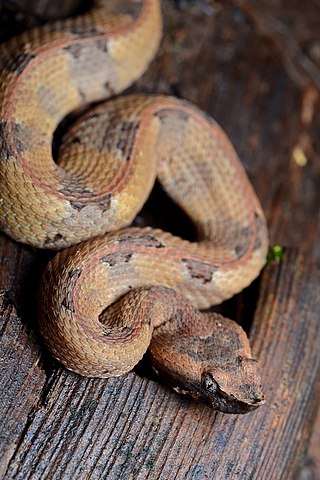
Porthidium nasutum is a pit viper species found in southern Mexico, Central America and northern South America. No subspecies are currently recognized.
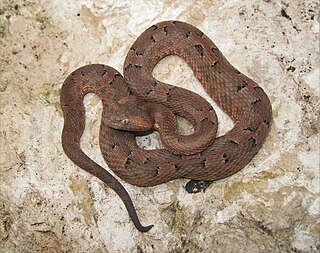
Porthidium yucatanicum is a pit viper species found in Mexico. No subspecies are currently recognized.

Porthidium lansbergii is a species of venomous snake, a pit viper in the family Viperidae. The species is endemic to Central and South America. Four subspecies are recognized, including the nominate subspecies described here.

Bothrops taeniatus, the speckled forest-pitviper, is a species of pit viper found in the equatorial forests of South America endemic to Colombia, Ecuador, Peru, And Brazil. The specific name, taenia, is derived from the Greek word, tainia, meaning ribbon bandage or stripe, in reference to the slender body. Two subspecies are currently recognized, including the nominate subspecies described here.
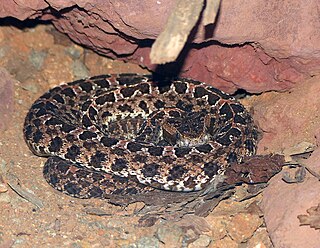
Porthidium ophryomegas is a venomous pitviper species found in Central America. No subspecies are currently recognized.

Porthidium volcanicum, the Ujarran hognosed pit viper, is a pit viper species endemic to Costa Rica. No subspecies are currently recognized.

Gloydius intermedius, or Central Asian pit viper, is a venomous species of pitviper endemic to northern Asia. Three subspecies are currently recognized, including the nominate subspecies described here.

Gloydius ussuriensis is a venomous pitviper species endemic to far east Russia, northeastern China and the Korean Peninsula. No subspecies are currently recognized.
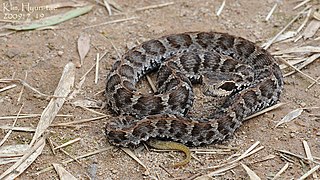
Gloydius brevicauda is a pit viper species endemic to China and the Korean Peninsula.
Bothrops medusa is a venomous pitviper species endemic to Venezuela. No subspecies are currently recognized.
Bothrocophias andianus is a venomous pit viper species endemic to the Andes in South America. No subspecies are currently recognized.
